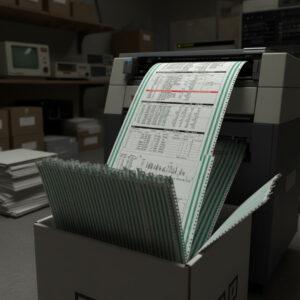What is a dot matrix printer? It is one of the earliest types of printers that paved the way for modern printing technology. Long before the rise of laser and inkjet printers, the dot matrix printer was widely used in offices, banks, and businesses. Even today, it continues to hold importance in industries where durability, cost-efficiency, and the ability to print multi-part forms are essential. In this article, we will explore the definition, product specifications, features, and uses of dot matrix printers to show why they are still valuable in certain settings.
Definition of a Dot Matrix Printer
A dot matrix printer is an impact printer that produces characters and images by striking a ribbon with pins in its print head. Each strike leaves a series of tiny dots on the paper, forming letters, numbers, or simple graphics. Unlike inkjet and laser printers, which spray or fuse ink onto the page, a dot matrix printer physically impacts the paper.
This impact-based process makes it possible to print on multi-part forms and carbon copies, which are still essential for many businesses. First introduced in the 1970s, dot matrix printers became known for their reliability, low running costs, and ability to handle continuous printing tasks. While they may lack the high resolution of modern printers, their functionality makes them ideal for specific professional environments.
Product Specifications of a Dot Matrix Printer
Dot matrix printers are designed with durability and practicality in mind. Below are common specifications:
- Printing Technology: Impact-based pin printing with ink ribbon
- Print Head Pins: 9-pin or 24-pin options (higher pin count = sharper text and graphics)
- Print Speed: 200 to 600 characters per second (CPS), depending on the model
- Print Resolution: 72 to 240 dots per inch (DPI), best suited for text-heavy tasks
- Paper Handling: Compatible with single sheets, carbon copies, and continuous fan-fold paper
- Durability: Rugged design, resistant to dust, heat, and industrial conditions
- Operating Costs: Very low; ribbons are inexpensive and last longer than cartridges or toner
- Connectivity: USB, parallel ports, or network options for modern models
- Noise Level: Louder than inkjet and laser printers due to mechanical impact
These specifications emphasize why dot matrix printers are not only long-lasting but also cost-efficient for businesses that require bulk or continuous printing.
Key Features of Dot Matrix Printers
Some of the most notable features include:
- Impact Printing: Ability to create carbon copies and multi-part forms
- Continuous Paper Support: Ideal for long reports and invoices
- Durability: Reliable even in dusty or hot environments
- Economical Printing: Very low cost per page compared to inkjet or laser printers
Product Uses of a Dot Matrix Printer
Dot matrix printers remain indispensable in industries that rely on carbon copies, bulk printing, or continuous form handling. Here are their most common uses:
- Banking and Financial Institutions
- Printing transaction logs, statements, and receipts that often need duplicates.
- Printing transaction logs, statements, and receipts that often need duplicates.
- Retail and Point of Sale (POS) Systems
- Generating bills, invoices, and multi-part receipts efficiently.
- Generating bills, invoices, and multi-part receipts efficiently.
- Transportation and Logistics
- Creating delivery notes, shipping forms, and waybills that require multiple copies.
- Creating delivery notes, shipping forms, and waybills that require multiple copies.
- Manufacturing and Industrial Settings
- Handling rugged environments where dust and heat may damage delicate printers.
- Handling rugged environments where dust and heat may damage delicate printers.
- Government and Administrative Offices
- Issuing permits, certificates, and multi-part forms for official use.
- Issuing permits, certificates, and multi-part forms for official use.
- Data Printing and Reporting
- Printing long reports, records, and logs on continuous fan-fold paper.
- Printing long reports, records, and logs on continuous fan-fold paper.
These uses highlight the practicality of dot matrix printers, making them more than just old technology they are still critical in specific professional settings.
Advantages and Limitations
Advantages:
- Low printing cost per page
- Can print on carbon copies and multi-part forms
- Extremely durable and reliable in demanding environments
- Long-lasting ink ribbons reduce operational expenses
Limitations:
- Lower resolution compared to modern printers
- Slower print speed for graphics-heavy tasks
- Noisy during operation
- Bulky design not suited for small offices or homes
Conclusion
So, what is a dot matrix printer? It is a reliable, impact-based printer that continues to serve industries where durability, cost efficiency, and carbon copy printing are vital. Although it may not compete with modern inkjet or laser printers in resolution or speed, it remains the printer of choice in banking, logistics, retail, government, and industrial environments.
For businesses seeking expert guidance and dependable printing solutions, Cal-Imaging Specialists Print and IT Solutions is here to provide the right products and services tailored to your operational needs.








